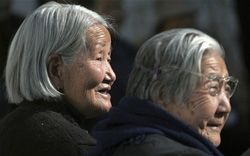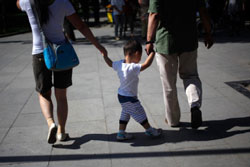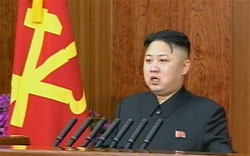News from China and North Korea
Tuesday's World Events — Posted on January 29, 2013
CHINA (news brief #1) – Population aging: 100-year waiting list for Beijing nursing home
 BEIJING | The shortage of elder care in China’s major cities has created a list of more than 10,000 applicants waiting for the 1,100 beds available in the capital’s No. 1 Social Welfare Home, according to the Beijing Evening News.
BEIJING | The shortage of elder care in China’s major cities has created a list of more than 10,000 applicants waiting for the 1,100 beds available in the capital’s No. 1 Social Welfare Home, according to the Beijing Evening News.
A staff member at the home told the newspaper that anyone applying now would have to wait a lifetime to get in. Numbers are so tight, he said, that only a dozen places were coming up each year. The public care home is located in the central district of Chaoyang, offers good care, and charges between $110 and $558 a month for a bed, making it extremely popular.
Elderly Chinese have traditionally lived with, and been looked after by, their children. However, China is aging rapidly. By 2015 there will be 220 million over-60s and within 40 years the number will rise to 500 million, one-third of a population that is expected to be just shy of 1.5 billion.
Encouraged by Chairman Mao, there was a baby boom in the early decades of Communist rule, followed in 1979 by the one-child policy and a sudden fall in the number of births.
Today, around 450,000 elderly in the Chinese capital live apart from their families, but Beijing only has around 215 public nursing homes and 186 private homes, or roughly three beds for every 100 seniors.
The city is rapidly expanding its facilities, and has promised 120,000 beds for old people by 2015, according to the Beijing Municipal Civil Affairs Bureau. But prices in the private sector can be steep: one luxury care home on the outskirts of the city charges 250,000 yuan ($39,804) a year.
The government’s policies are likely to continue with the basic concept of ‘nine-seven-three’: 90 per cent of old people will live at home, seven per cent will get government care and three per cent will live in private facilities.
[The city of] Shanghai, meanwhile, has also drawn up plans to ramp the number of elderly care homes and to import care-givers from other provinces in China.“We have been open for more than a decade, but we always struggled to fill our 60 beds,” said Gu Yuqing, the sprightly 74-year-old owner of Ai Wan Qing, a care home in Shanghai’s suburbs. “That all changed two years ago. And in the past two months we have been getting constant calls. We are full to bursting,” she added.
“Beforehand, young people worried that if they put their parents into a home, the neighbors would criticize them behind their backs. But that has all changed now. And for older people, they sometimes prefer to be independent.” Mrs Gu is now eying a project in Shanghai’s suburbs where her residents will be able to play golf and tennis.
CHINA (news brief #2) – Pressure Rises on Government to Scrap One-Child Policy
 BEIJING | China’s top national statistician on Friday (Jan. 18) called for changing the country’s one-child policy because of the nation’s shrinking pool of workers, adding to a chorus of opponents who say the policy will have long-lasting effects on the country’s economic stability.
BEIJING | China’s top national statistician on Friday (Jan. 18) called for changing the country’s one-child policy because of the nation’s shrinking pool of workers, adding to a chorus of opponents who say the policy will have long-lasting effects on the country’s economic stability.
The absolute size of the working population, aged 15 to 59, fell by 3.45 million people to 937 million last year, Ma Jiantang, head of China’s National Bureau of Statistics, said in a news briefing.
Mr. Ma’s comments come as many Chinese demographers call for an end to the family-planning policy, which was implemented in 1980 to manage a population explosion encouraged by Chairman Mao Zedong. They argue that [continuing to implement] birth restrictions threatens the country’s labor force, which has been the backbone of its economic growth in recent decades.
The policy has also come under criticism for enforcement tactics including forced abortions and sterilizations. Such practices are illegal in China but sometimes enforced by local officials under pressure to meet population targets. …In June…the case of Feng Jianmei, a 23-year-old woman who was forced to undergo a late-term abortion, drew nationwide outrage after photos of her and the aborted [baby] appeared online.
Beijing has been sending mixed signals about its plans for the policy. In November, when Communist Party leaders gathered for the 18th Party Congress, leaders flagged in a blueprint document for policy makers that the government would “steadily improve the population policy and promote long-term and balanced population growth.” Most interpreted that to mean that change would be coming, said Wang Feng, a population expert and director of the Brookings-Tsinghua Center for Public Policy in Beijing.
But on Tuesday the head of China’s National Population and Family Planning Commission dismissed speculation that the one-child policy would be scrapped in the near future. Minister Wang Xia said in a commission meeting that maintaining a low birth rate will be a top priority.
…
Demographers have warned for years that China’s population decline could threaten its economy. The reserve of future workers, meaning those under the age of 14, made up 16.6% of the population in 2010, according to a once-a-decade census released the following year. That was down from 23% a decade earlier. China’s population totaled 1.339 billion in 2010, reflecting an average annual growth rate of 0.57% over the past decade. In the decade that ended in 2000, the growth rate was 1.07%. …
There are a number of new exceptions to the one-child policy. Minority groups are exempt, and anyone with enough money can get around penalties for having a second child. Rural families whose first child is a girl may have a second child, as can married couples who are both themselves only children.
Mr. Wang, a member of a group of demographers, academics and former officials who have been calling for the one-child policy to be replaced with a two-child limit, said a smaller labor force puts upward pressure on wages and will likely result in higher rates of inflation. …
Mr. Wang said there is wide consensus among scholars that there is no justification for the continuation of the one-child policy. “Change is inevitable, but with further delay, greater harm will be done,” Mr. Wang said.
NORTH KOREA – Government steps up surveillance of citizens with 16,000 CCTV cameras
North Korea purchased 16,420 closed-circuit surveillance cameras from China in the first 11 months of last year as the regime stepped up the monitoring of its own people.
That figure is on top of the 85,570 similar cameras that it has bought in the past three years, with the total cost running to more than $9.77 million, according to South Korea’s Chosun Ilbo newspaper.
Citing Chinese export statistics on its trade with North Korea, the paper quoted analysts as saying that many of the cameras are being positioned at key points along the long border the two nations share in order to detect and capture would-be defectors from the North.
The new regime of Kim Jong-un has carried out a crackdown on people hoping to escape their repressive homeland, as well as anyone using a mobile phone to communicate across the border and smugglers bringing in banned newspapers, books and recordings of television programs that show the lives of people in prosperous South Korea.
“All surveillance equipment there has something to do with the regime’s attempt to tighten its control over society,” a South Korea government official told the paper.
Evidence that North Korea is tightening its control on the lives of the people coincides with a new report by the United Nations high commissioner for human rights that concludes with a request that an international investigation be carried out into Pyongyang’s “deplorable” record on its citizens’ rights.
In a statement issued in Geneva, Navanethem Pillay said, “There were some initial hopes that the advent of a new leader might bring about some positive change in the human rights situation.
“But a year after Kim Jong-un became the country’s new supreme leader, we see almost no sign of improvement.”
(The news briefs above are from wire reports and staff reports posted at London’s Daily Telegraph on Jan. 15 and Jan. 16 and WSJ.com on Jan. 18.)
Background
CHINA’S ONE-CHILD POLICY:
The one-child policy …is the population control policy of the People’s Republic of China (PRC). … It officially restricts the number of children married urban couples can have to one, although it allows exemptions for several cases, including rural couples, ethnic minorities, and parents without any siblings themselves….
The Chinese government introduced the policy in 1979 to alleviate social, economic, and environmental problems in China, and authorities claim that the policy has prevented more than 250 million births from its implementation to 2000. The policy is controversial both within and outside China because of the manner in which the policy has been implemented, and because of concerns about negative economic and social consequences. The policy has been implicated in an increase in forced abortions and female infanticide, and has [caused a] gender imbalance in China….
The policy is enforced at the provincial level through fines that are imposed based on the income of the family and other factors. Population and Family Planning Commissions exist at every level of government to raise awareness about the issue and carry out registration and inspection work [to ensure that every couple only have a child when it is their turn to do so, designated by the committee]. (from wikipedia.org)
ON THE NORTH KOREAN GOVERNMENT: (from the CIA World FactBook)
- An independent kingdom for much of its long history, Korea was occupied by Japan in 1905 following the Russo-Japanese War. Five years later, Japan formally annexed the entire peninsula. Following World War II, Korea was split with the northern half coming under Soviet-sponsored Communist domination.
- After failing in the Korean War (1950-53) to conquer the U.S.-backed South Korea (Republic of Korea – ROK) by force, North Korea (DPRK), under its founder President Kim Il Sung, adopted a policy of ostensible diplomatic and economic “self-reliance” as a check against excessive Soviet or Communist Chinese influence.
- North Korea demonized the U.S. as the ultimate threat to its social system through state-funded propaganda, and molded political, economic, and military policies around the core ideological objective of eventual unification of Korea under Pyongyang’s control.
- Kim Il Sung’s son, [dictator] Kim Jong Il, was officially designated as his father’s successor in 1980, assuming a growing political and managerial role until the elder Kim’s death in 1994.
- After decades of economic mismanagement and resource misallocation, North Korea since the mid-1990s has relied heavily on international aid to feed its population while continuing to expend resources to maintain an army of approximately 1 million. [Aid agencies estimate that a famine from 1995-1997 killed 2 million to 3 million North Koreans. Foreign food aid was given to North Korea, but the government distributed the majority of it to the military and party leaders.]
- North Korea’s history of regional military provocations, proliferation of military-related items, and long-range missile development – as well as its nuclear, chemical, and biological weapons programs and massive conventional armed forces – are of major concern to the international community. [Kim Jong-il was an oppressive dictator who required that his people call him "Dear Leader"]

